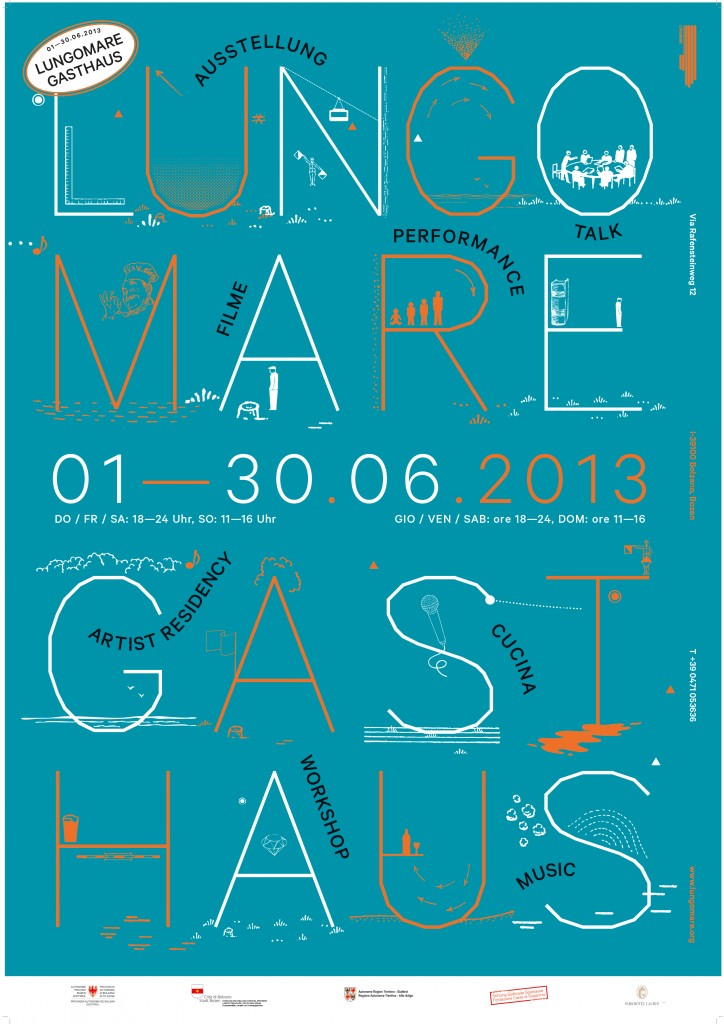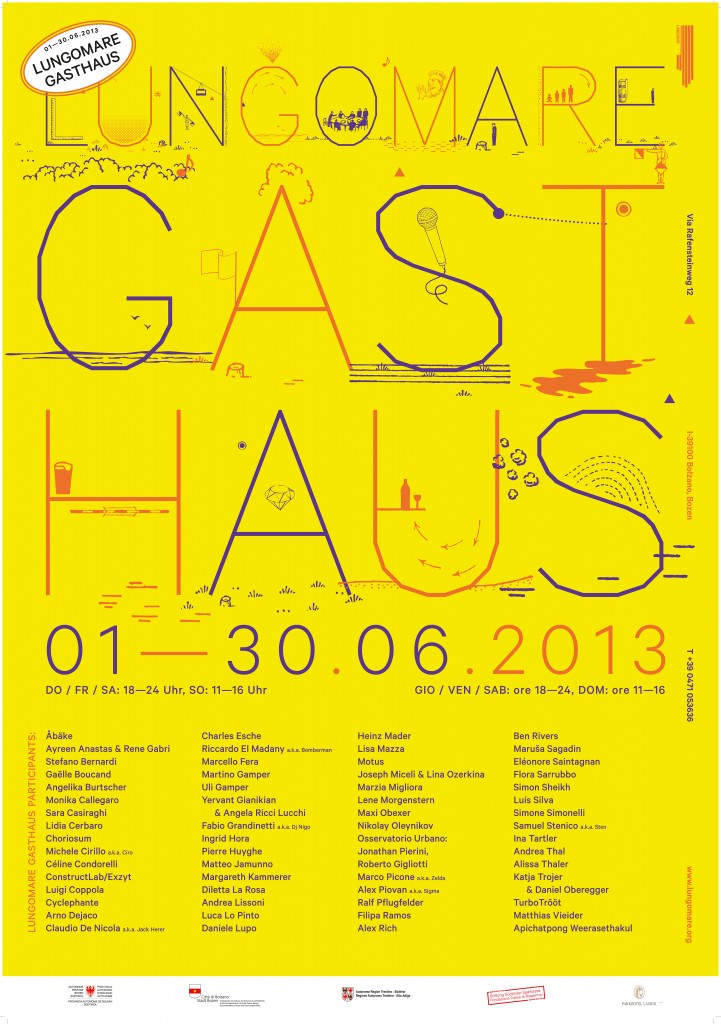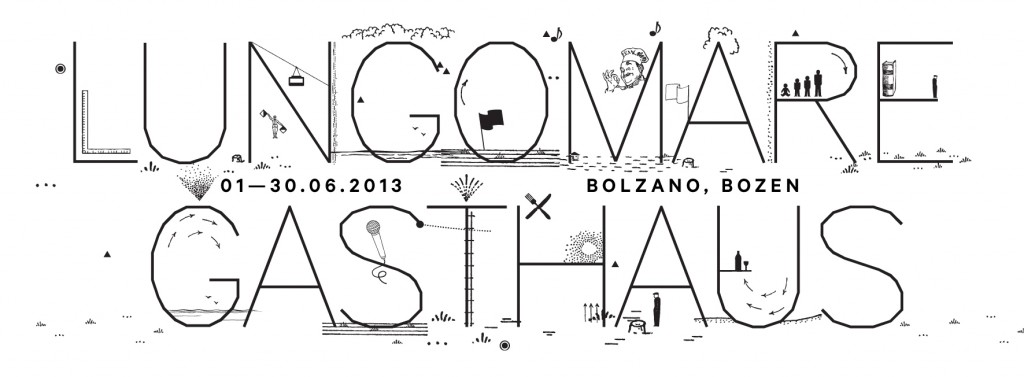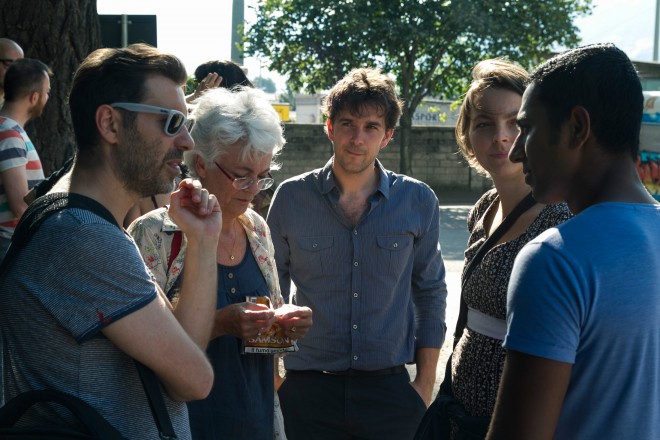Lungomare Gasthaus
In June 2013, to celebrate the tenth-year anniversary of its founding, the project space Lungomare will open the Lungomare Gasthaus as a temporary space for thought and action. The Lungomare Gasthaus integrates the kitchen—a cultural and social place of production—into a one-month program consisting of discussions, conversations and workshops, a series of spatial interventions, a film program and a series of public performances and actions in the city of Bolzano.
A Gasthaus, or tavern, is an important setting in the context of our everyday lives—a place for meeting and conviviality, negotiation and exchange. Thus, the Lungomare Gasthaus will also provide the framework for dialogue and actions in which international and national artists, designers, musicians and thinkers are invited to reflect on our present. The Lungomare Gasthaus aims to use this free space as an occasion to challenge given conditions in an expanded dialogue, compare thoughts, work out positions and test concrete opportunities for action—both now and for change in the future.
The Lungomare Gasthaus program touches on topics that have persisted through the space’s projects since its founding: territory and its socio-political complexity, public space as common property and a site of interaction for the urban population, transdisciplinarity and cultural-politically immanent questions as to the conditions of cultural production.
Besides the project initiators Angelika Burtscher, Daniele Lupo and Lisa Mazza—who are responsible for the overall direction and basic structure of the project and the curation of individual contributions—two other actors and “accomplices”, Luigi Coppola and Filipa Ramos, have collaborated to shape the monthly program as artist- and curators-in-residence.
Lungomare, Piazza Matteotti, Piazza del Grano, Prati del Talvera, Pippo (via Cadorna)
Program conceived with:
Filipa Ramos
Luigi Coppola
- Åbäke
- Alex Piovan a.k.a. Sigma
- Stefano Bernardi
- Gaëlle Boucand
- Monika Callegaro
- Sara Casiraghi
- Choriosum
- Claudio De Nicola a.k.a. Jack Herer
- Céline Condorelli
- Luigi Coppola
- Cyclephante
- Arno Dejaco
- Agata Erlacher
- Fabio Grandinetti a.k.a. Dj Nigo
- Marcello Fera
- Beatrice Galilee
- Martino Gamper
- Uli Gamper
- Roberto Gigliotti
- Ingrid Hora
- Pierre Huyghe
- Matteo Jamunno
- Joseph Miceli & Lina Ozerkina
- Margareth Kammerer
- Katja Trojer & Daniel Oberegger
- Diletta La Rosa
- Andrea Lissoni
- Lo Pinto Luca
- Heinz Mader
- Marco Picone a.k.a. Zelda
- Michele Cirillo a.k.a. Ciro
- Marzia Migliora
- Lene Morgenstern
- Maxi Obexer
- Nikolay Oleynikov
- Ralf Pflugfelder
- Jonathan Pierini
- Paolo Plotegher
- Filipa Ramos
- Riccardo El Madany a.k.a. Bomberman
- Alex Rich
- Eléonore Saintagnan
- Samuel Stenico a.k.a. Sten
- Flora Sarrubbo
- Simon Sheikh
- Luis Silva
- Simone Simonelli
- Ina Tartler
- Andrea Thal
- TurboTrööt
- Matthias Vieider
Exhibition / Performance / Objects
Impressions and experiences inscribe themselves in our actions, leaving their traces in things, spaces and places. Our decisions in the now are based on what was; at the same time, we are guided by our subjective emotions, our social and political environment, our knowledge, and critical analysis of our reality.
A series of works on the topic “When Yesterday Becomes Tomorrow” will be produced within the context of the Lungomare Gasthaus, reflecting on past projects, methods and approaches at Lungomare. The project room archive will serve as a point of departure while casting a utopian look into the still unwritten future of Lungomare and our world of tomorrow, as a way of giving potentials a playful scope for development. Some works provide food for thought, raise questions as to conditions and changes in cultural production, and strive to locate themselves and build a connection to the South Tyrolean region. “When Yesterday Becomes Tomorrow” includes interventions, a series of performances and objects, and an exhibition at the Lungomare Gasthaus.
Curated by Angelika Burtscher, Daniele Lupo and Lisa Mazza
With:
Åbäke & Martino Gamper & Alex Rich, Stefano Bernardi, Ingrid Hora & Maxi Obexer, Heinz Mader, Joseph Miceli & Lina Ozerkina, Marzia Migliora, Osservatorio Urbano: Roberto Gigliotti & Jonathan Pierini, Maruša Sagadin
Maruša Sagadin
Installation consisting of a spatial element, various objects and collages
Several apartment complexes in Bolzano became the starting point for an analysis of the boundaries between public and private spheres and the impact of the built environment on the behavior of its inhabitants. At the Lungomare Gasthaus, the dwellings have been replaced by pieces of scenery showing the structures in the form of spatial elements, sculptures and collages. The artist’s invented protagonists form a new community in the spatial setting. The work mixes theory with practice, reality and fiction, private and public, exoticism and local examination.
Production: LMGH
Stefano Bernardi & Heinz Mader
10 vinyl records and 10 drawings
Stefano Bernardi and Heinz Mader’s joint work is characterized by sound, sign and action. The project consists of creating a series of 10 vinyl records, upon which Stefano Bernardi has etched traces of projects made by Lungomare during its first ten years of activity. Edited like samples, the public can play these accounts, stories, discussions, visions and productions on the DJ consoles installed for the exhibition. In the same way, Heinz Mader traces the sign of his visual suggestions on the record covers. His poetics of the absurd, irony, sarcasm and provocation meet Stefano Bernardi’s chorus of traces.
Production: LMGH
Osservatorio Urbano: Roberto Gigliotti & Jonathan Pierini
Workshop and poster series
Founded by Lungomare in 2005, the “Osservatorio Urbano”, a platform and network for urban strategies, uses an interdisciplinary approach to discuss ways of reading and describing the contemporary city. With interventions that focus on aspects such as the spontaneity, emotion and unpredictability of the urban context, the “Osservatorio Urbano” is structured as an open laboratory, permitting direct contact with the images and impressions inhabitants have of their city. The shared exploration “Where the Things are Wild—displays, news, places“ on Bolzano’s urban space for communication is looking at the boundaries between real and metaphorical places of information within the city and experimenting with opportunities to create interferences and interaction between them.
Marzia Migliora
Series of 216 white ceramic dishes
Marzia Migliora’s project takes its title from the former Italian Minister of Culture Giulio Tremonti’s lapidary sentence “you can’t eat culture” justifying the cuts to culture, research and education funding. Inspired by her love of cooking and the aesthetics of the table, the artist realized a series of ceramic plates that provoke an exchange between the people seated for the meal.
Each dish shows a quote extracted from the speeches of politicians on the issue of culture. Lungomare Gasthaus becomes the scene of a hypothetical parliament, one where the set table appears as an open discourse in itself, with opposing points of view alternating back and forth. Migliora’s work encourages us to take sides and discuss the issues brought to the table, while culture is ironically served as a meal. In this way, we are asked to consider culture the same way we think of food — as essential to the health and of a human mind.
Production: LMGH
Åbäke, Martino Gamper & Alex Rich
08/06/2013
A fire place in the middle of the garden, people are sitting around it ready to take part in the evening long dinner. The hosts of the evening Martino Gamper, Åbäke and Alex Rich change the spatial setting of the Gasthaus for the evening and invite the guests to interact with them as well as to enter in dialogue with each other. Rather than recreating and archaic moment to celebrate nature and the pure way of living the evening is a way of questioning how we will live in the future and how our being in common can be shaped. Developed for the Lungomare Gasthaus “trattoria circolare” is a re-edition of the “trattoria al cappello” project that the four designers have started more than ten years ago in London stimulated by a common passion for food, cooking and the interest to trigger unusual moments of interaction and dialogue.
A performative talk with Ingrid Hora & Maxi Obexer
In 1967, Italian engineer Giorgio Rosa laid the foundation for a 400 m2 steel-and-concrete platform that he called “Insulo de la Rozoy” in Esperanto, meaning the “Isle of Roses” or “L’isola delle rose”. The island was built eleven kilometers from the Italian coast – just outside the national waters – and was thus a “free state”.
The micro-nation in the immediate vicinity of Rimini was soon the subject of the wildest rumors and attracted projections of all kinds – but it was one thing above all: a utopia. After 80 days, the island was occupied and bombarded by the Italian coast guard.
Ingrid Hora and Maxi Obexer are taking the idea of this island as an occasion for a performative discussion, raising questions as to how a place, a country or even a utopia can be thought of as a “new homeland” without resorting to national definitions and constructions.
Cinema
“This is my land” is the title of a film by Ben Rivers showing the everyday life of Jake Williams, a man who retired to a forest in northeastern Scotland to live on his own, in a self-sufficient manner, and in direct contact with nature. Due to the representation of such an empathetic relationship between an individual, a place, and the filmic medium used to present it, “This is my land” became the title for a four-week program of film works that explores the sense of belonging and observes the existent or potential relations established between individual people, institutions and territories. It will present works by artists and filmmakerswho use film and video to document these ties in a myriad of contexts, often leading us to observe how vicinity is not so much a matter of physical closeness but of empathy towards shared behaviors and feelings.The program explores how artist’s cinema can have a unique role in disclosing, weaving and looking into the complex phenomena that root persons to places. On each cinema night either one of the filmmakers or another guest will be speaking about the films.
Curated by Filipa Ramos
Films:
06/06
In the presence of the filmmaker Gaëlle Boucand
This is my land
Ben Rivers
UK, 2006, 14’, 16mm, s/w, stereo
JJA
Gaëlle Boucand
FR, 2012, 51’, HD, color, stereo
13/06
In the presence of Hich Bourdane and Giovanni Fassina (president and vice president of MAIA Onlus – Make An Impact Association Onlus)
What Everybody Knows
Ayreen Anastas & Rene Gabri
PS/US, 2006-2008, 1h58’
20/06
Introduction by Andrea Lissoni (curator)
Un film abécédaire
Eléonore Saintagnan
FR, 2010, 21’, Video, color, stereo
Streamside Day Follies
Pierre Huyghe
USA, 2003, 26’, film/video, color, stereo
27/06
Introduction by Rinaldo Censi (author, film critic and curator)
A Letter to Uncle Boonmee
Apichatpong Weerasethakul
THAI, 2009, 17’40’’, 16mm, color, stereo
Das Lied von der Erde: Gustav Mahler
Yervant Gianikian & Angela Ricci Lucchi
IT, 1982, 17’, 16mm, color
Performance
Act 1: Resistance
Act 2: Harmony or conflict?
Act 3: Vision and prophecy
Exercises in Political Chorality
“Masses & Motets” are three musical performances that focus on having one’s say, the resistance to entertainment and consumer society, political declaration, proposal and vision. The choir symbolizes the ability of a group of people to “agree” and to create a shared harmony through moments in which their individual or collective voices are in dialogue or in conflict. The artists involved come from different musical and performance backgrounds, including hip-hop, performative literature, polyphonic singing, theater, slam poetry, easy listening and experimental music. The project is rooted in the writings of authors who continue to leave their mark in terms of political imagery, such as Langer, Pasolini,
Gramsci and Beuys, and also contains original writings specially created for the project. The performances will first take place in public spaces around the city and then at Lungomare Gasthaus in a group performance.
A project by Luigi Coppola
In collaboration with Marcello Fera and Ina Tartler
Performances:
06/06, 07/06, 14/06/2013
Act 1: Resistance
Alex Piovan a.k.a. Sigma, Michele Cirillo a.k.a. Ciro, Riccardo El Madany a.k.a. Bomberman, Marco Picone a.k.a. Zelda, Claudio De Nicola a.k.a. Jack Herer, Fabio Grandinetti a.k.a. Dj Nigo, Samuel Stenico a.k.a. Sten (Hip Hop), Arno Dejaco, Matteo Jamunno, Matthias Vieider (performative literature)
Act 2: Harmony or conflict?
Choriosum (choir), Arno Dejaco, Matteo Jamunno, Matthias Vieider (performative literature)
Music: Marcello Fera
Text: Arno Dejaco
Act 3: Vision and prophecy
Monika Callegaro, Lidia Cerbaro, Lene Morgenstern, Diletta La Rosa, Flora Sarrubbo, Alissa Thaler (easy listening, recitation, slam poetry), Arno Dejaco, Matteo Jamunno, Matthias Vieider (performative literature)
Production: LMGH
Artist Residency
During the last two weeks of Lungomare Gasthaus, there will be two short artist residences that will produce a series of site-specific actions. Luigi Coppola has chosen two artistic practices that, despite different artistic approaches, are both politically rooted in the artistic action and relational impetus that they activate through their processes.
Curated by Luigi Coppola
13 — 23/06
Nikolay Oleynikov: Learning Mural
Artist Residency and workshop
Production: LMGH
24 — 30/06
Motus
Artist Residency and performance
13 —23/06/13
Nikolay Oleynikov
Learning Mural is a form of alternative educational practices, including the formation of temporary collectives, that result in the production of a certain (monumental) art piece, typically based on narrative plot and bodily, artistic, discursive practices of communal living, including martial arts, sleepovers, collective readings, music, dance, discussions, drinking marathons, street politics, wall painting, screenwriting, you are free to continue this list. During his residency, the artist will collaborate with a group of people to create a site-specific Learning Mural at the Lungomare Gasthaus.
Motus_ 2011>2068 AnimalePolitico Project
Keeping your eyes open and reacting to facts like wolves in the forest. Heading out alone, outside of the group, or moving with the group as a single body, to re-situate the now and imagine phosphorescent tomorrows. The piece is divided into three parts:
WHen: A solitary act in which “an obscure observation” had by P.K. Dick guides a debate between the director and the actress about movement and control, non-compliance and obedience… about dramatic license.
WHO: A midnight choral Act involving the joint and confused movement of performers and the audience. Mimicries of masked bodies in the wild: a disordered and libertarian, quasi-folkloric dance…
WHeRe: A meeting about the alternative means of managing spaces and culture, in which public language and individual memory are interwoven.
Conversations
Can a month become a meeting point? Can an anniversary be a landmark? This desire—to turn a period of time into a place of encounter, and to convert a festivity into a moment of reflection—shaped the Sunday Brunch project. The 10th anniversary of Lungomare serves as an occasion to think about its nature and envisage its future next to that of analogous institutions. Not wishing to engage in such considerations alone, and believing that the role of independent spaces should be discussed collectively in a pleasant and amiable way, we have invited a series of individuals we admire to come and spend some time with us. During four weekends, artists, curators, designers, and others who have been thinking about institutions, shaping their ever-changing nature and imagining their outcome, will come to Bolzano and join us for an open Sunday Brunch at Lungomare Gasthaus.
Curated by Filipa Ramos
With:
02/06: Céline Condorelli
Respondent: Cecilia Canziani
09/06: Luca Lo Pinto, Andrea Thal
Respondent: Martina Oberprantacher
16/06: Ralf Pflugfelder, Beatrice Galilee
Respondent: Monica Carmen
23/06: Simon Sheikh, Luís Silva
Respondent: Paolo Plotegher
Architecture
ConstructLab/exyzt for Lungomare are Alexander Römer, Gonzague Lacombe, Patrick Hubmann and Mattia Pacco-Rizzi. They are responsible for the design and construction of the spatial situation at the Lungomare Gasthaus. An open kitchen and bar nestles against the existing Lungomare building on the ground floor. A cantilevered structure creates a protection roof for the lower area while the space upstairs is transformed into a multifunctional arena for performances, film screenings, talks and ideas. The wooden structure strikes a visual contrast with the picturesque rural landscape, distances itself from the traditional building types and modern villa architecture and instead takes its cue from the occasional industrial elements in the landscape, The wooden structure creates a contemporary stage design inspired by the ruins of an ancient Greek theater. ConstructLab/exzyt is developing architectural elements in three public places in the city (Piazza del Grano, Piazza Matteotti, Prati del Talvera).
Concept: Teatro del Mare by ConstructLab/exyzt
The seating and tables are designed by Simone Simonelli. Approximately 300 linear meters of wood is needed to build 50 seats. The seats will be realized with wood and materials that can be found in any hardware shop. The seats will be constructed during a workshop, which offers a participatory and collective experience to re-discover manual skills and confidence in working with common tools.
Kitchen
The Lungomare Gasthaus celebrates the wealth, quality and abundance of products mostly from the region. The menu is influenced by notions of identity, territory and originality, and will serve as a catalyst for a fruitful realm of encounter, discussion, sharing and exchanging. The menu was conceived after numerous visits to local producers, farmers and small artisan manufacturers, not only to source the ingredients but also to meet the people, get to know their ideology and understand their mission. Some of the products used are ones that have disappeared and are carefully being brought back to the market by our partners; it is a tribute to biodiversity and a pleasant surprise for taste buds. The menu will include a selection of antipasti followed by weekly changing main dishes, both meatbased and vegetarian. Uli Gamper is responsible for the overall culinary concept at the Lungomare Gasthaus and will be assisted by Agata Erlacher. The menu itself will change over the course of the month according to the availability of products. Fresh herbs and flowers will be grown on location, integrated into the open kitchen structure.
Guest:
20 — 23/06
Sara Casiraghi, pentolapvessione
Bolzano Caput Mundi
Recipes from the World of the Talisman of Happiness





Dolomiten: 01./02.06.
Alto Adige: 05.06.
Alto Adige: 07.06.
Dolomiten_8./9.06
Lukas Bertagnolli: Politische Etüden. Dolomiten: 19.06.

Daniela Mimmi: Lungomare tra cinema, musica e performance. Alto Adige_27.06
Alto Adige: 28.06.
Lukas Bertagnolli: Fest für die kleine Stadt. Dolomiten, 29./30.06
Lukas Bertagnolli: Stürzendes Zoon Politicon. Dolomiten, 6./7.07.
Domus Nr. 971_Luglio/Agosto 2013
blog.atcasa.corriere.it, 31.05.
atp diary
atp diary 1
Tageszeitung, 31.05.
altoadige.gelocal.it, 01.06.
Franzmagazine, 03.06.
Franzmagazine, 03.06./1
Franzmagazine, 03.06./2
Franzmagazine, 03.06./3
Franzmagazine, 03.06.2013/4
Franzmagazine, 03.06./5
Franzmagazine, 04.06.
Franzmagazine, 05.06.
pigmag, 06.06.
Franzmagazine, 06.06.
Franzmagazine, 06.06./1
Franzmagazine, 07.06.
Franzmagazine, 07.06./1
Franzmagazine, 10.06.
Franzmagazine, 10.06./1
Franzmagazine, 10.06.2013/2
Franzmagazine, 11.06.
salto.bz, 11.06.
Franzmagazine, 14.06.
Franzmagazine, 14.06./1
Franzmagazine, 17.06.
Franzmagazine, 17.06./1
Franzmagazine, 17.06./2
Franzmagazine, 17.06./3
Franzmagazine, 19.06.
pentolapvessione, 20.06.
Franzmagazine, 24.06.
Franzmagazine, 24.06./1
Franzmagazine: 24.06./2
Franzmagazine, 25.05.
domus, 27.06.
Franzmagazine, 28.06.
Franzmagazine, 01.07.
ewo
Frutop
Kammerlander
Würth
franzmagazine.com
Antonio Dalle Nogare Collection
Pippo Food Chill Stage
Festival Transart
Vinilficio
Zelig
Food & Drink Partners:
Ahrntaler Natur
Altromercato
Aspinger Raritäten
BergnerBräu
Bio*Beef
Biokistl
Sarner Forellenzucht
Prader Dorfsennerei
Daniel Primisser
Hans Rottensteiner
Schullian
Ultner Brot
Messnerhof
Agostini
What´s on
EXHIBITION :: Binta Diaw :: Collective Practices – A Living Experience of Feeling ListenedAbout Lungomare
Lungomare, a cultural association founded in Bolzano in 2003, was created from the desire and necessity to open a space in which to share differences, experiences, opinions and desires, a space in which to make the link between cultural production and the political and social dimension. Lungomare undertakes projects that investigate and test possible relationships between design, architecture, urban planning, art and theory, the results of which are presented in different formats: public discussions, conferences, publications, exhibitions and interventions in public spaces. All these formats are characterised by the intention to interact with cultural and socio-political processes relating to the region in which Lungomare is located.
Currently Lungomare’s activities focus on long-term residency projects, a format whereby Lungomare invites guests to engage and interact within the context of South Tyrol. Lungomare’s activities are based on three principles: specific attention to the context in which the association’s projects are undertaken, the transdisciplinary approach that distinguishes these projects, and reflection on the role of Lungomare as a cultural institution in connection with the region in which it operates.
Territory
Lungomare is located at the edge of Bolzano, the capital of South Tyrol, and relates to the context in which it operates, attempting to highlight the dynamics of change. Large urbanized areas alternate with broad areas of intensive cultivation and yet others of picturesque landscape, all of which penetrate the centre of the city. The city is surrounded by mountains and this is one of the reasons why the tourism industry has become a driving force in this locality. The demographic structure of the city has been characterized for a long time by the coexistence of two populations, those speaking German and those speaking Italian. However, the social and demographic composition of Alto Adige Südtirol is changing. Migrants, including those from non-European countries are making their way to the area to settle, whilst others, including political refugees, are flowing through the region.



